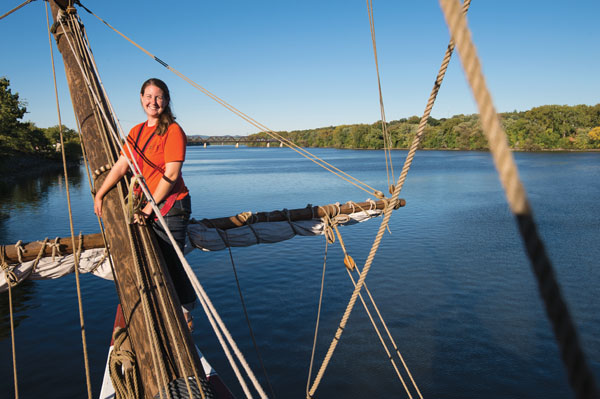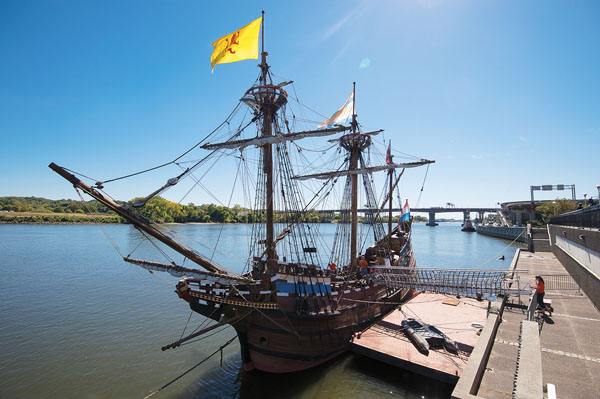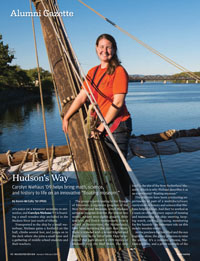Alumni Gazette
 HANDS-ON DECK: Niehaus (left), program director of the New Netherland Museum, promotes hands-on learning aboard the Half Moon
(above), a replica of the ship by the same name that Henry Hudson sailed in 1609. (Photo: Adam Fenster)
HANDS-ON DECK: Niehaus (left), program director of the New Netherland Museum, promotes hands-on learning aboard the Half Moon
(above), a replica of the ship by the same name that Henry Hudson sailed in 1609. (Photo: Adam Fenster)It’s early on a weekday morning in September, and Carolyn Niehaus ’09 is boarding a small wooden ship anchored in the Hudson River just south of Albany.
Transported to the ship by a small motorboat, Niehaus gains a foothold on the hull, climbs several feet, and jumps on to the deck where she joins a small crew and a gathering of middle school students and their teachers.
The group is participating in the Voyage of Discovery, a signature program of the New Netherland Museum, which Niehaus serves as program director. For almost two weeks, Albany area eighth graders, their teachers, and Dutch counterparts from a school in Heerenveen, the Netherlands, have been retracing the path that Henry Hudson traveled with a mixed English and Dutch crew in the fall of 1609. They’ve retraced that path aboard a 1989 replica of Hudson’s ship, the Half Moon. The ship itself is the site of the New Netherland Museum, which is why Niehaus describes it as an experiential “floating museum.”
The students have been conducting experiments as part of a multidisciplinary curriculum in history and science that Niehaus helped design. And they’ve worked as a team on virtually every aspect of running and maintaining the ship: steering, keeping watch, cooking, cleaning, monitoring for fire hazards—an important role on this mostly wooden vessel.
As the predawn fog has lifted and the sun begins to shine, the group prepares to raise the anchor. It’s a complex process, Niehaus explains, and a prime example of the discipline and teamwork that the voyage instills. “It’s important to be quiet, so they can all hear each other, because they can’t see each other,” she says as the students divide into three groups and scurry off to separate stations on the ship.
 (Photo: Adam Fenster)
(Photo: Adam Fenster)When Niehaus graduated from Rochester, she didn’t expect she would be more than passing through her hometown of Albany. But when she was offered a job with the museum, she found it hard to resist.
William Reynolds, the captain of the Half Moon and director of the museum, made sure to make it so. He met Niehaus in 1999 when she was an eighth grade participant in a version of the program she now directs. “Right off the bat, she showed real leadership,” he says. She started giving dockside tours of the ship. In high school, she recruited friends to join her. After she went off to Rochester, Reynolds recalled a visit she made to the museum’s small office as her graduation was approaching. “I nabbed her,” says Reynolds.
“I really enjoyed working with my hands but also being mentally stimulated,” Niehaus says of her early connection to the Half Moon. “I really enjoyed being in this challenging environment and figuring out how to get things done.”
At Rochester, she majored in English literature and designed her own minor field in sustainability. Although she’s an experienced deckhand and has performed multiple roles on the crew, these days she spends more time in the office and on the road, managing virtually every aspect of running and continuing to build the museum.
A major focus of hers is working with K–12 educators to design hands-on, experiential curricula geared to New York State learning standards. It’s also a strength, she says, growing out of her broad liberal education and the ways in which she was encouraged as a college student to draw connections among concepts and disciplines. “That’s what I loved about Rochester,” she says. “I could study all these topics and connect them for myself.”
It’s not a surprise, Niehaus finds, that other Rochester friends have been drawn to playing roles in the Voyage of Discovery program. Among them are Julia Cosgrove ’11, who sailed on the Half Moon as a seventh grader, studied ecology and evolutionary biology at Rochester, and joined students in the summer of 2008 to work on shipboard science projects. Sara DuBois ’10, who majored in anthropology and Russian studies, played a similar role. And Carl Adair ’08, who majored in English and is a doctoral student in English at Princeton University, sailed last summer on the Half Moon, serving as the ship’s cook.
Niehaus’s leadership has been critical in ensuring the Half Moon has an integral role to play in advancing learning across disciplines, touching on standards taught in science, math, social studies, and English.
During the Voyage of Discovery, students have learned about mechanical advantage, the way in which levers and pulleys amplify force, helping students lift and move heavy items. They’ve tracked the rise and fall of tidal heights, current speeds and direction, the rise and fall of celestial objects. “These are topics we’ve chosen because they show repeatable, predictable patterns,” she says. “The students can collect this data and graph it and get curves that show them that if they take measurements in a way that is regularized or repeatable, they can predict what will happen.”
It’s a lesson that many children learn in textbooks. But Niehaus is working to make the Half Moon experience more broadly accessible. “I’ve been working on a livestreaming program so that students can tune in and watch a live videostream of students presenting their projects,” she says. As classroom students see how their peers have collected data, they can use that data to form their own graphs and draw their own conclusions. Livestreaming, Niehaus says, offers “a personal connection. It’s their peers who are collecting the data.”
As the Half Moon approaches its dock in downtown Albany, a crowd of parents, civic leaders, and reporters await, as they have each year since 2009, the 400th anniversary of Hudson’s journey and the year Dutch students began participating in the program. When the welcoming ceremony is over, Niehaus will return to the office to prepare for the publication of a brand new curriculum, “Indians of the Hudson Valley.” Like every other set of lessons she helps design, it’s an interdisciplinary mix—covering history, economics, cross-cultural exchange, and ecology and the environment.
As winter approaches, she’ll coordinate the museum’s sizeable base of volunteers, as together they re-outfit the ship with replica artifacts for regular, public dockside tours as well as school tours.
She’ll be seeking more opportunities to share the museum’s resources with other kinds of audiences, such as corporate groups and incoming high school or college classes. “It’s a great way to build a leadership community,” she says, referring to the day-to-day teamwork required to operate the ship.
And she’ll be preparing for the next Voyage of Discovery. Interest in the program, she says, has been self-sustaining. “It’s driven by teachers—teachers who say, ‘This is great, we want to be a part of this’—and then help to make that happen.”

